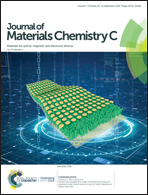Lanthanide grafted phenanthroline-polymer for physiological temperature range sensing†
Abstract
Accurate measurement of the temperature is crucial as it determines the dynamics of almost any system. Conventional contact thermometers are not well suited for small scale measurements. Temperature dependent luminescent materials, i.e. materials that emit light of different color at different temperature, are therefore of particular interest in the development of noncontact thermometers. Luminescent materials consisting of lanthanide ions feature high thermal sensitivity, high photostability and high quantum yields. These ions possess very interesting light emitting properties. By anchoring them onto different backbone materials, their light absorption is increased. The search for a backbone that allows the sensor to be active in a defined temperature range, with a high detection sensitivity is ongoing. This work reports the first insoluble phenanthroline-polymer (phen-polymer) backbone on which europium (Eu3+) and terbium (Tb3+) trifluoroacetylacetone (tfac) complexes are easily grafted in a 1 : 1 metal ratio in order to create a noncontact temperature sensor. Two clear, discriminable emission peaks were observed during the photoluminescence study at room temperature, demonstrating that this material can be used as a ratiometric thermometer. The characteristic emission peak correlated to Eu3+ transition is slightly stronger than the emission peak of Tb3+ transition, resulting in a yellow emission color. The maximum value of the relative temperature sensitivity was calculated to be 2.3404% K−1 (340 K), which indicated good thermometric behavior. The emission color of the designed phen-polymer@Eu,Tb_tfac changed from light green (260 K) to orange-red (460 K). The thermometer can therefore be used as a ratiometric noncontact temperature sensor in the broad physiological temperature range.



 Please wait while we load your content...
Please wait while we load your content...